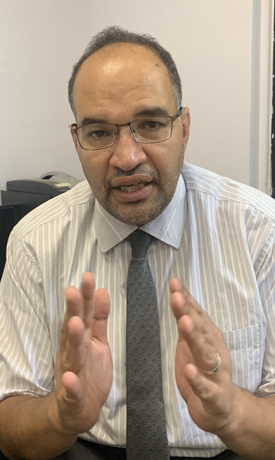Egypt’s COVID-19 peak, in terms of new infections, came on 19 June when more than 1,700 new cases, and more than 90 fatalities, were reported. This week, the average daily infection hovered around 700, and deaths dropped to 80 per day. On Monday, 16 hospitals in nine governorates reported no new COVID-19 patients.
Ain Shams field hospital was established in mid-June to deal with the spiralling number of cases. It was set up in just 15 days, in cooperation with the Armed Forced Engineering Authority and the Tahya Misr fund. The hospital has so far hosted 168 patients, of which 117 have been released after making a full recovery. The hospital’s ICU now has just eight patients.

Ashraf
Is there a discrepancy between the number of infected COVID-19 patients officially announced and the actual number?
Any discrepancy is because the announced numbers of COVID-19 patients include only those who have undergone a nasopharyngeal swab at a hospital affiliated to the Ministry of Health, or at the ministry’s central laboratories. Patients treated at private clinics or hospitals, or who have nasopharyngeal swabs at private laboratories, are not included in the official numbers. Also, patients with mild symptoms who isolate at home, or those with moderate symptoms who did not have a nasopharyngeal swab, will be uncounted.
The number of new cases appears to be dropping. Why?
Protective measures, and the weakening of the virus, are among the main reasons the number of COVID-19 patients, and of fatalities, is falling. The majority of patients display mild symptoms, without the respiratory complications that require hospital or ICU admission, and therefore do not undergo a swab test.
Our main concern centres on the elderly, and people who suffer from chronic diseases such as diabetes and hypertension, or who have heart, kidney or liver problems.
Egypt’s desert climate, with extremely high temperatures during the summer months, especially in Upper Egypt, is helping halt infections. And the relatively low number of cases and fatality rate in Egypt may suggest that the strain of COVID-19 here is not as aggressive as in some countries.
Do current treatment protocols differ from those adopted earlier in the pandemic?
The Ministry of Health has issued a standardised guide for the diagnosis and management of COVID-19. Under the protocol, patients are classified on clinical grounds into mild, moderate, severe and critical cases. The medical protocol adopted relies on a medical team composed of different specialties — pulmonology, internal medicine, tropical medicine, infectious diseases, intensive care, radiology, clinical pathology, clinical pharmacy, and infection control — to take care of patients in quarantine hospitals. Each patient has their own medical protocol depending on their general health condition. The medical protocol is determined in collaboration with the medical team caring for the patient, with reference to the patient’s blood tests and CT scans.
The protocols have changed as we learned more about the virus. In the early days we were treating the symptoms, not the disease.
Now we have a clear plan. We use anticoagulants, cortisone, vitamins and oxygen in some cases. Remdesivir is used in critical cases.
After the patient is released from hospital we follow up for two weeks to make sure that there are no further health problems.
Which cases must be hospitalised rather than treated at home?
Cases with mild clinical symptoms, with no signs of pneumonia in chest imaging, and moderate cases with symptoms such as fever or manifestations of chest disease, or imaging results indicative of pneumonia, generally do not need to be hospitalised and can quarantine at home. Severe and critical cases, with the previously mentioned symptoms along with respiratory problems or respiratory failure, must be hospitalised, and some may need to be placed in an IC.
Why is the infection rate so high among medical staff such as doctors and nurses?
It is the result of exposure to the virus due to contact with patients. Doctors and nurses dealing with COVID-19 patients should not be in direct contact with patients unless they are wearing a face mask, goggles, face shield, gloves and the sterilised suit specially designed for dealing with COVID-19 patients. However, it is possible that a doctor or a nurse forgets to wear the goggles or the gloves.
Members of medical teams stay in the hospital for 14 days, after which team members should be tested for COVID-19 through nasopharyngeal swabs. Negative team members are released for home self-isolation for another 14 days. Positive members, if any, stay in the quarantine hospital for medical care.
Should we fear from a second wave?
A second COVID-19 wave is expected to reach Egypt in winter, with the drop in temperature. Low temperatures, and a relaxation of social distancing measures, increases the possibility of a second wave. The field hospital will remain operating so we can deal with the situation.
We hope people will be more resistant to any coming wave, that large numbers will have formed anti-bodies against the virus.
Is a COVID-19 vaccine a possibility soon?
The government has announced a deal with AstraZeneca, the multinational pharmaceutical company, to supply Oxford University’s vaccine for COVID-19, though the quantities involved have not been revealed. I don’t think a COVID-19 vaccine will be available for at least a year.
*A version of this article appears in print in the 23 July, 2020 edition of Al-Ahram Weekly
Short link: